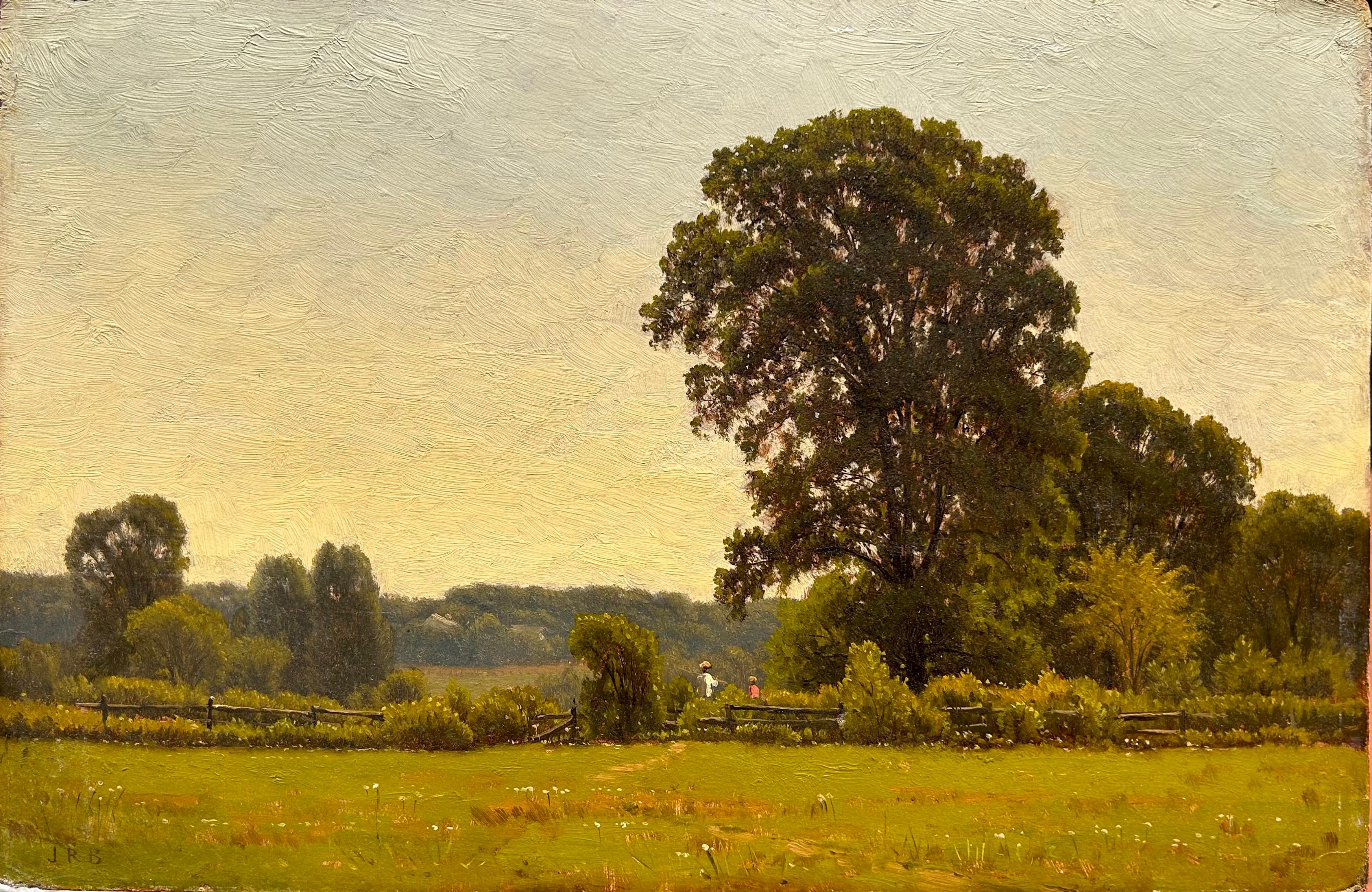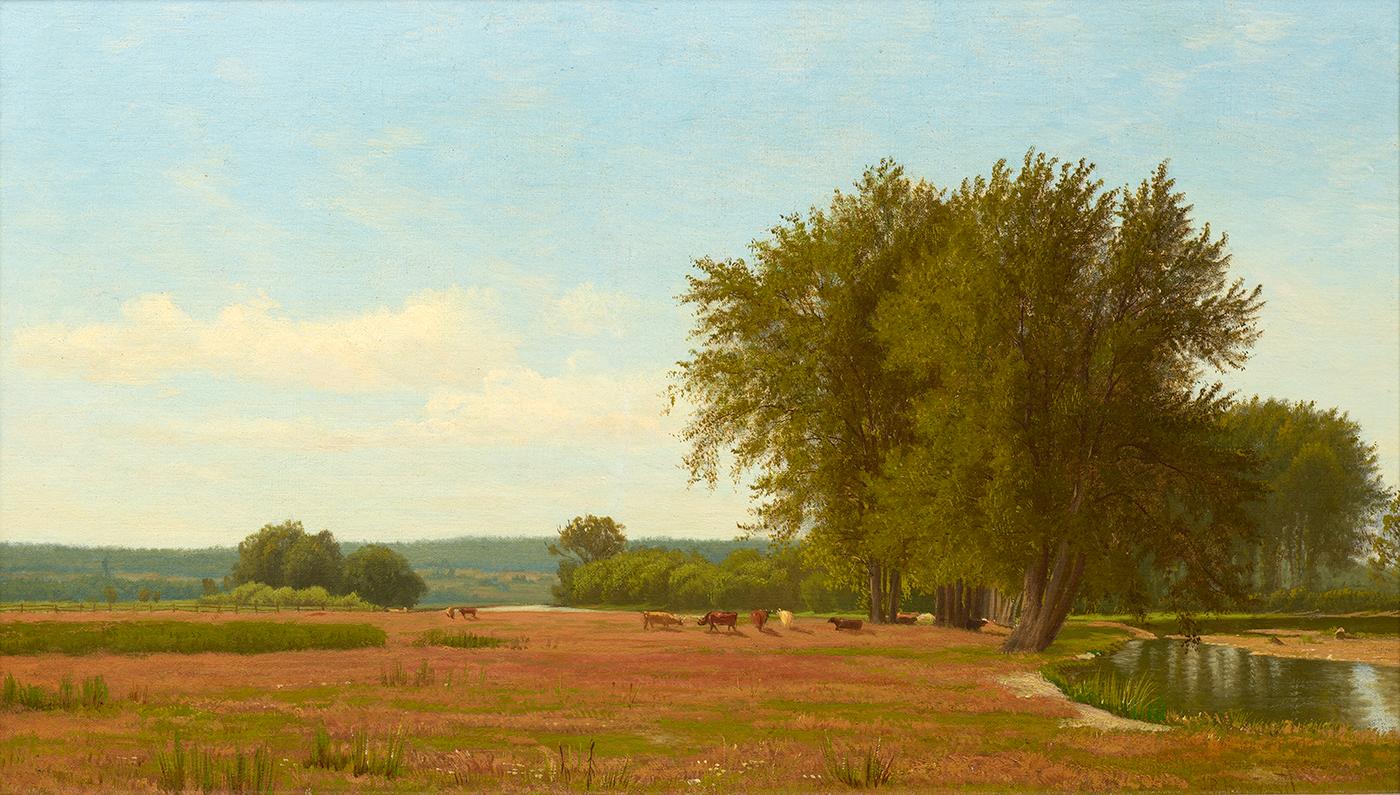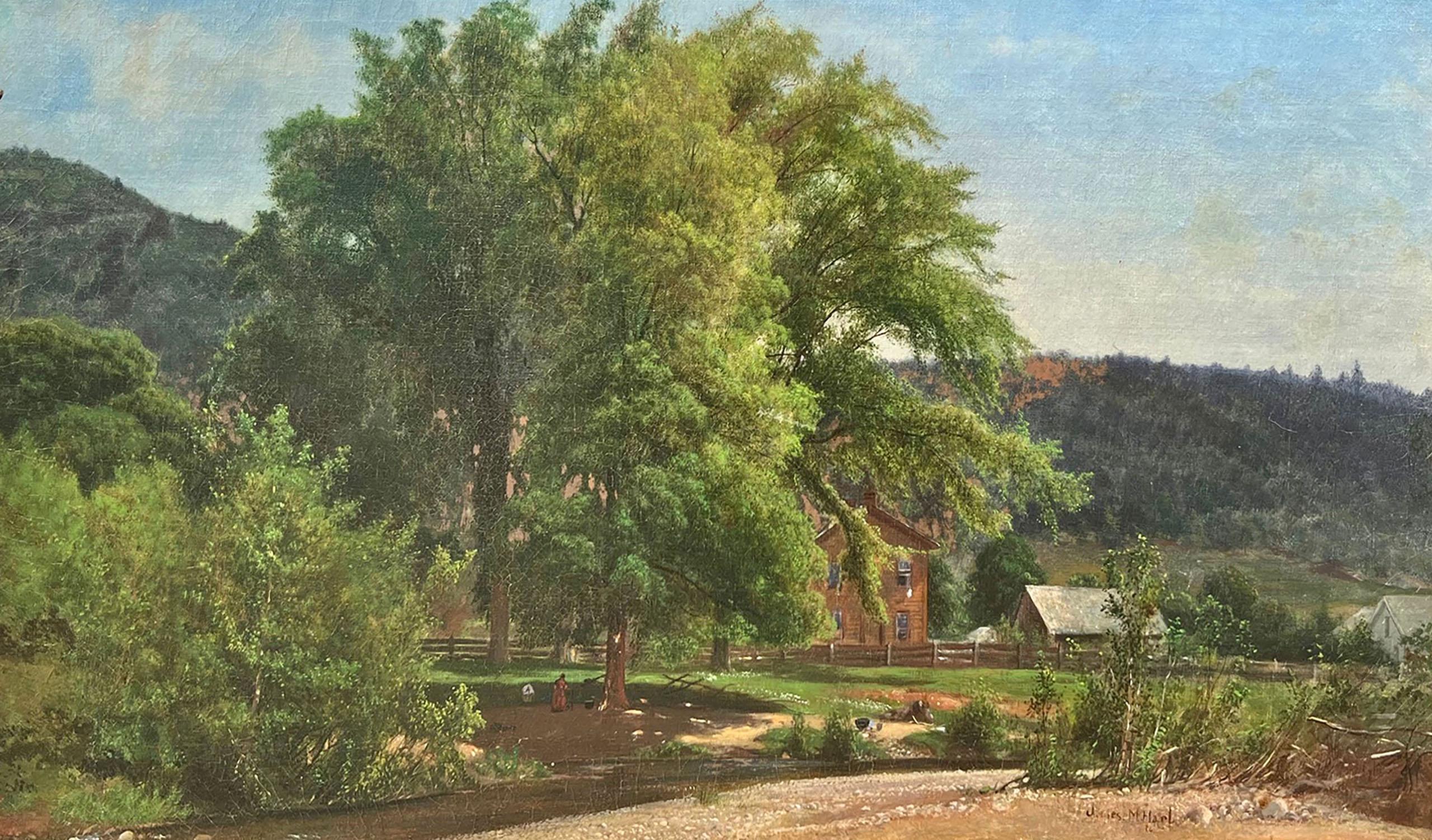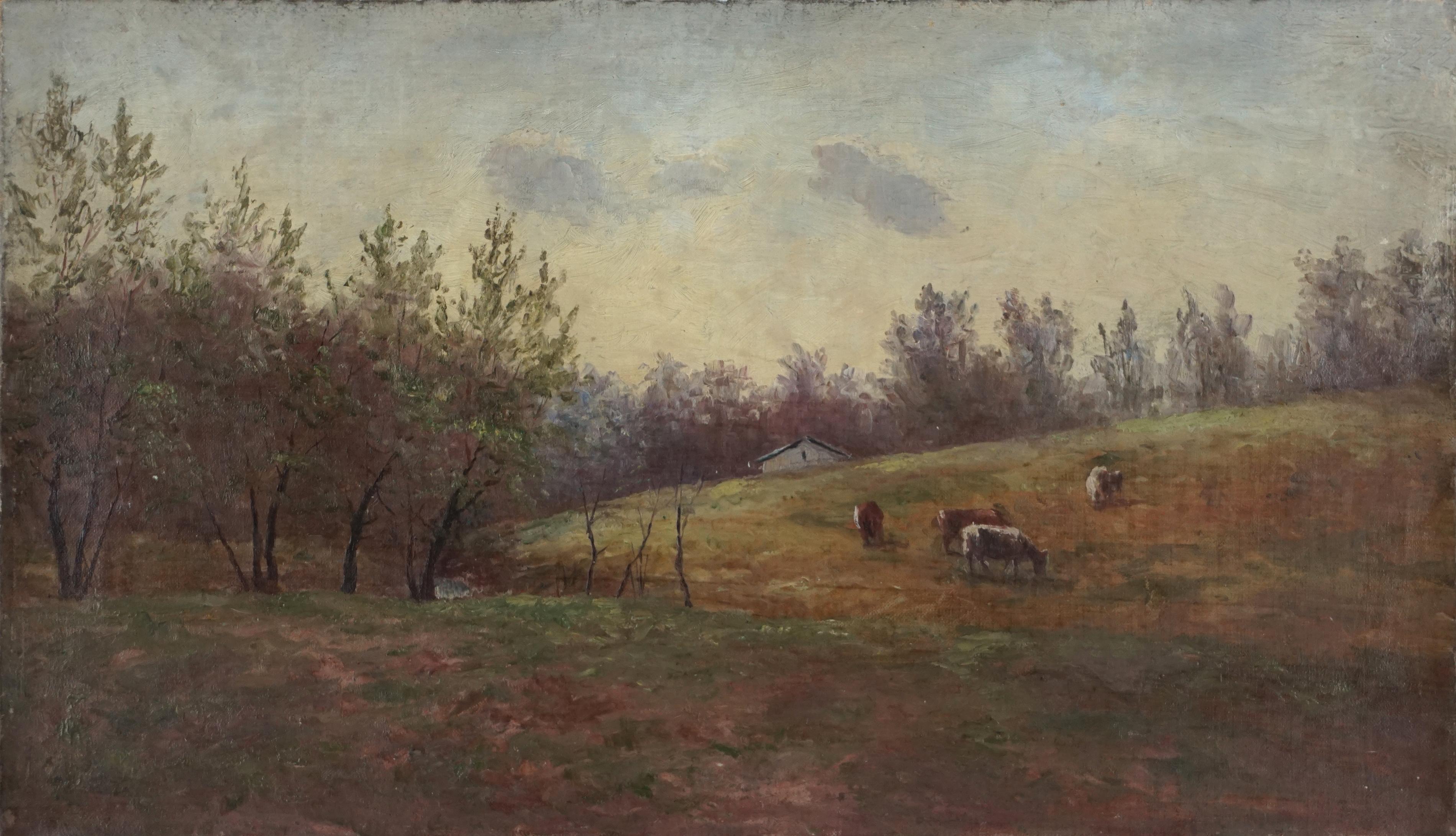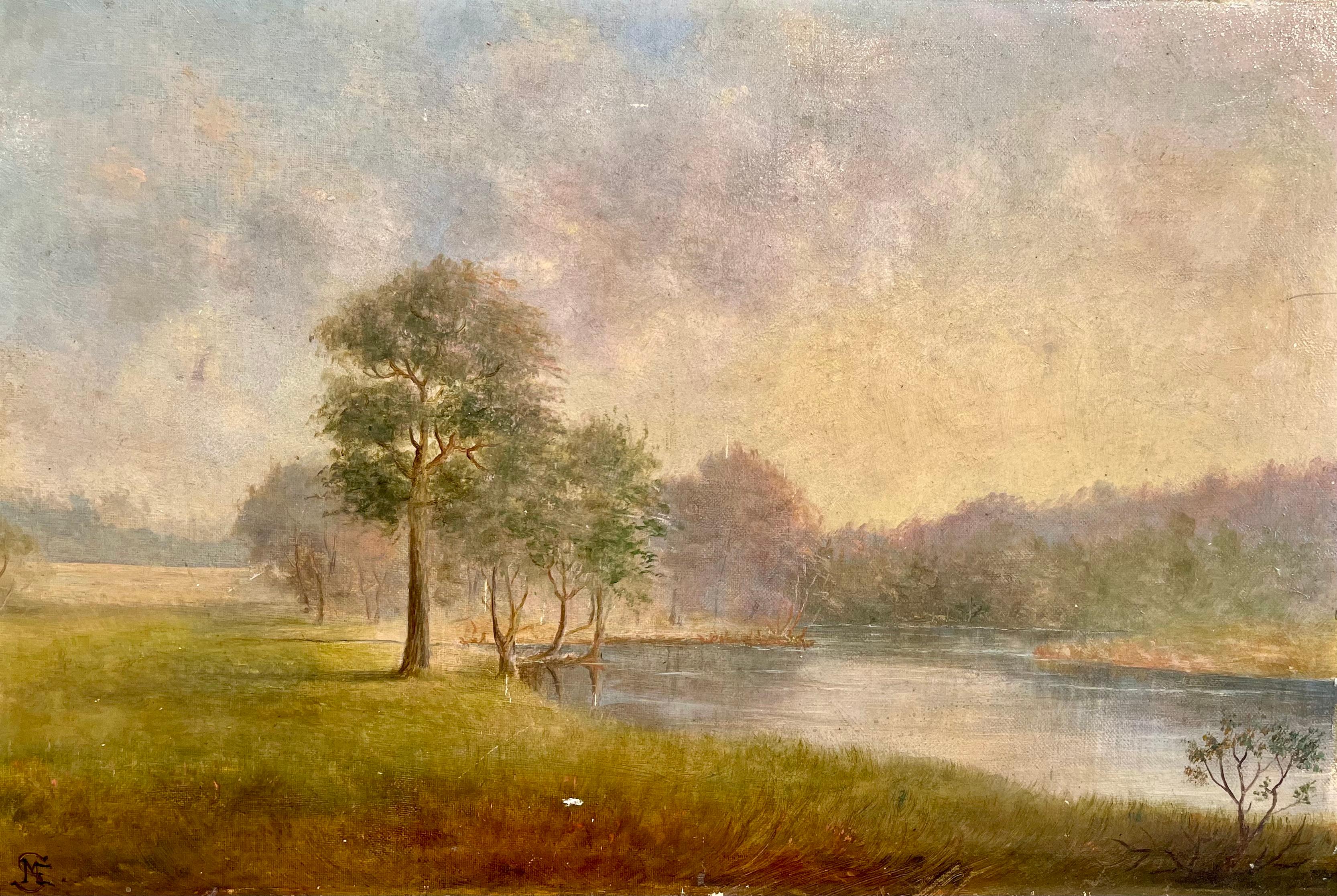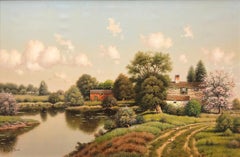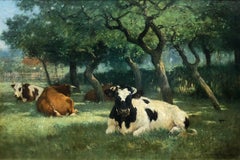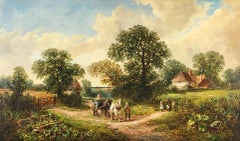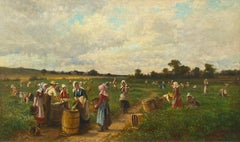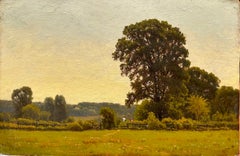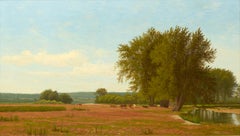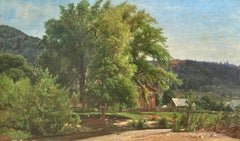Items Similar to A Day in June, Scene Eastchest, New York
Want more images or videos?
Request additional images or videos from the seller
1 of 14
Edward B. GayA Day in June, Scene Eastchest, New York1898
1898
Price Upon Request
Price Upon Request
Price Upon Request
Price Upon Request
Price Upon Request
Price Upon Request
Price Upon Request
Price Upon Request
Price Upon Request
Price Upon Request
About the Item
A Day in June, Scene Eastchest, New York
Edward Gay (Irish, American, 1837-1928)
Oil on Canvas
Complimented by original frame in great condition
Signed and Dated Lower Right
Titled and Signed on Label on Reverse
30 x 25 inches
40.5 x 35.5 inches with frame
Growing up in Albany, New York, Edward Gay was among the hundreds of thousands of Irish emigrants who relocated to the United States and Canada in the wake of the Potato famine. After settling in Albany, Gay began his art studies with the local Hudson River School artist James Hart, also an emigrant of the British Isles. By 1858, at the age of twenty one, Gay was exhibiting at the National Academy of Design in New York.
By 1868, he had moved to New York City, only to relocate to Mount Vernon two years later to accommodate the needs of a growing family. He would spend the next fifty-eight years painting southern Westchester County. Early on he was the typical Hudson River School artist, but later he adopted a Barbizon manner by capturing the mood and light of many of Westchester County's quiet nooks and crannies.
Not only was he long lived, but he was very successful. Gay was a member of the both the Century Association and the prestigious Union League Club of New York. His works found their way into many museums and public collections; among them are the Metropolitan Museum of Art, NY; the New-York Historical Society, NY; Westchester Woman's Club, Mt. Vernon, NY; Brigham Young University, Provo, Utah; Nelson-Atkins Museum of Art, Kansas City, MO; Munson-Williams-Proctor Institute, Utica, NY; and the Union League Club, New York, NY.
- Creator:Edward B. Gay (1837-1928, American)
- Creation Year:1898
- Dimensions:Height: 30 in (76.2 cm)Width: 25 in (63.5 cm)
- Medium:
- Movement & Style:
- Period:
- Condition:
- Gallery Location:Missouri, MO
- Reference Number:1stDibs: LU747315822872
About the Seller
5.0
Vetted Professional Seller
Every seller passes strict standards for authenticity and reliability
Established in 1970
1stDibs seller since 2017
155 sales on 1stDibs
Typical response time: 1 to 2 days
- ShippingRetrieving quote...Shipping from: Missouri, MO
- Return Policy
Authenticity Guarantee
In the unlikely event there’s an issue with an item’s authenticity, contact us within 1 year for a full refund. DetailsMoney-Back Guarantee
If your item is not as described, is damaged in transit, or does not arrive, contact us within 7 days for a full refund. Details24-Hour Cancellation
You have a 24-hour grace period in which to reconsider your purchase, with no questions asked.Vetted Professional Sellers
Our world-class sellers must adhere to strict standards for service and quality, maintaining the integrity of our listings.Price-Match Guarantee
If you find that a seller listed the same item for a lower price elsewhere, we’ll match it.Trusted Global Delivery
Our best-in-class carrier network provides specialized shipping options worldwide, including custom delivery.More From This Seller
View AllSpringtime at the Farm
Located in Missouri, MO
George W. Drew (1875-1968)
"Springtime at the Farm"
Oil on Canvas
24 x 36 inches (site)
31.5 x 43.25 (framed)
George W. Drew was born 21 December 1875 in Massachusetts. He was a member of the Independent Artists Association. He exhibited at the National Academy of Design and they have him recorded as living at 745 Columbus Ave., N.Y. in the year 1898. He also exhibited at the Allied Artists of America, which was established in 1914, Salons of America, N.Y. State Fair, Newark State Fair, Newark Museum and New York Museum of Science & Industry.
Although there is little known about the personal life of George W. Drew, his paintings appear on the art market quite often. It is obvious that his work has always been well received because of the numerous exhibitions he has participated in. He is known for his rustic luminous depictions of the Nineteenth Century American Landscape. Like many of the Hudson River Painters...
Category
Early 20th Century American Impressionist Landscape Paintings
Materials
Canvas, Oil
Price Upon Request
Made in the Shade
By William Henry Howe
Located in Missouri, MO
William Henry Howe (1846-1929)
"Made in the Shade" 1887
Oil on Canvas
Signed and Dated
Site Size: approx. 14.5 x 21.5 inches
Frames Size: approx. 17.5 x 24.5 inches
Provenance: Private Collection, St. Louis, Missouri thence by descent
William Henry Howe was born in Ravenna, Ohio in 1846. Of him it was written: "In the late nineteenth century no American artist was more thoroughly identified with the painting of cows than William Henry Howe." (Richter 128). In a style that combined Tonalism and Realism, he was a painter of light-filled pastoral landscapes that sometimes had sheep as well as cattle tended by their shepherds and herders.
He began a career as a businessman in St. Louis, and in his mid-thirties, changed course and went to Dusseldorf Germany to study art at the Royal Academy. In 1881, he went to Paris and studied with animal painters Felix Vuillefroy and Otto de Thoren. He also exhibited his work at the Paris Salons and the Paris Universal Exposition of 1889.
Travels in Holland in the 1880s with other artists inspired his interest in pastoral subjects, and during that time he began his cattle paintings...
Category
1880s American Impressionist Animal Paintings
Materials
Canvas, Oil
Price Upon Request
The Haywagon
By James Edwin Meadows
Located in Missouri, MO
James Edwin Meadows (British 1828-1888)
"The Haywagon" 1866
Oil on Canvas
Site: 24 x 40 inches
Framed: 30 x 46 inches approx.
A London landscape painter, James Edwin Meadows was the...
Category
Late 19th Century Land Landscape Paintings
Materials
Canvas, Oil
Price Upon Request
Bean Picking, New Jersey, 1890
By Frederick Rondel
Located in Missouri, MO
Bean Picking, New Jersey, 1890
By. Frederick Rondel (1826-1892)
Signed Lower Right
Unframed: 21.5" x 35.5"
Framed: 32" x 46"
Frederick Rondel, born in Paris in 1826, came to America...
Category
19th Century French School Landscape Paintings
Materials
Canvas, Oil
Price Upon Request
Sundown
By Robert Robin Fenson
Located in Missouri, MO
Robert Robin Fenson (Active 1889-1914, British)
"Sundown"
Oil on Canvas
16 x 23.5 (site)
19 x 27 (framed)
Category
Late 19th Century Land Landscape Paintings
Materials
Canvas, Oil
Price Upon Request
Sunset
By James Fairman
Located in Missouri, MO
James Fairman
"Sunset" c. 1880
Oil on Canvas
Signed Lower Left
Site: 32.5 x 29.5 inches
Framed: 46 x 42 inches
James Fairman worked as a landscape painter, critic, lecturer, musicia...
Category
1880s American Realist Landscape Paintings
Materials
Canvas, Oil
Price Upon Request
You May Also Like
Oil Summer Landscape
Located in Fredericksburg, VA
James Renwick Brevoort (1832–1918) was an influential American landscape painter associated with the Hudson River School, a mid-19th century art movement known for its romantic portr...
Category
Mid-19th Century Hudson River School Landscape Paintings
Materials
Oil, Board
Summer Landscape
By James Renwick Brevoort
Located in New York, NY
Signed lower right: JR Brevoort
Category
1860s Hudson River School Landscape Paintings
Materials
Canvas, Oil
Summer at the Farm by James McDougal Hart (American, 1828-1901)
By James McDougal Hart
Located in New York, NY
"Summer at the Farm," by Hudson River School painter James McDougal Hart (American, 1833-1915) is oil on canvas and measures 14 x 24 inches. It is signed and dated by Hart at the low...
Category
19th Century Hudson River School Landscape Paintings
Materials
Canvas, Oil
Pastoral Landscape
By Edward B. Gay
Located in Milford, NH
A fine pastoral landscape by Irish artist Edward B. Gay (1837-1928). Gay was born in Dublin, Ireland, and emigrated with his to Albany, NY at a very young age as a result of the pota...
Category
1870s American Impressionist Landscape Paintings
Materials
Canvas, Oil
19th Century Hudson River School Bucolic Landscape
By John Frederick Kensett
Located in Soquel, CA
Beautiful example of the Hudson River School romantic bucolic New York autumn landscape with cows foraging. Illegible artist signature on stretcher bar (See enhanced images). Condition: very good; professionally cleaned and minor restoration upper right hand corner where paint was missing.
Unframed.
Image size: 14"H x 24"W x .75"D
Hudson River School was an informal association was America's first so-called school of painting and the dominant landscape style until the Civil War. The name derives from a group of 19th-century landscape painters working in New York state. With realistic composition, they depicted romantic views of unsettled areas of the Hudson River Valley especially lakes, rocky gorges, and forests in the Catskill Mountains. About a fourth of these artists utilized luminism or effects with special lighting techniques to convey lofty emotions through contrasts of light and dark. Included in this Hudson River luminist category were Washington Allston, Albert Bierstadt, William Hart, and Frederic Edwin Church...
Category
1870s Hudson River School Landscape Paintings
Materials
Linen, Oil
Charles River Meadows, MA
Located in Fredericksburg, VA
"Charles River Meadows, Massachusetts" by Mark E. Slayton is a masterful landscape painting that embodies the beauty characteristic of the Hudson River School. As a prominent artist ...
Category
Mid-19th Century Hudson River School Landscape Paintings
Materials
Canvas, Oil
More Ways To Browse
New York Antique
Antique Nelson
James Nelson
Antique Oil Painting Ireland
Early Utah Painting
Vernon Oil Paintings
B Vernon
Antique Potato
Edward B Gay
Vintage Christmas Scenes
Antique George Washington Painting
Eagle Oil Painting
Landscape With Ducks
Midcentury European Street Scene Painting
Modern Farmhouse Painting
Modern Paintings Palm Trees
Moonlit Landscape
Mountain Sunrise
